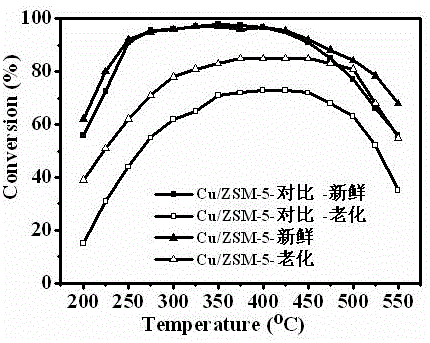Copper-based molecular sieve catalyst as well as preparation method and application thereof
A molecular sieve and catalyst technology, applied in the field of catalyst preparation, can solve the problems of limited catalytic activity and hydrothermal stability, achieve excellent catalytic activity, increase loading capacity, and improve catalytic activity
- Summary
- Abstract
- Description
- Claims
- Application Information
AI Technical Summary
Problems solved by technology
Method used
Image
Examples
preparation example Construction
[0021] A preparation method of a copper-based molecular sieve catalyst, comprising the following steps in turn:
[0022] Step 1: First measure the saturated water absorption rate of the molecular sieve carrier, then add the molecular sieve carrier to the soluble copper salt solution for vibration and ultrasonic impregnation to obtain a uniformly dispersed catalyst slurry, wherein the copper ions in the soluble copper salt solution and the molecular sieve carrier The mass ratio is 3-8:100, and the volume of the soluble copper salt solution is the product of the quality of the molecular sieve carrier and its saturated water absorption;
[0023] Step 2: The catalyst slurry is pre-frozen and vacuum-dried at minus 50 to minus 20° C., and then calcined to obtain a copper-based molecular sieve catalyst.
[0024] In the first step, before measuring the saturated water absorption of the molecular sieve carrier, the molecular sieve carrier is calcined and then cooled to room temperature...
Embodiment 1
[0035] A preparation method of a copper-based molecular sieve catalyst is carried out in accordance with the following steps:
[0036] Step 1: first calcinate the molecular sieve carrier at 500°C for 2 hours, then cool it to room temperature, then measure the saturated water absorption of the molecular sieve carrier, then add it to an aqueous solution of copper nitrate for shaking and ultrasonically impregnate it at 40°C, 100W, and 30KHz for 2 hours, To obtain a uniformly dispersed catalyst slurry, wherein the molecular sieve carrier is H-SSZ-13 powder, the mass ratio of copper ions in the copper nitrate aqueous solution to the molecular sieve carrier is 8:100, and the volume of the copper nitrate aqueous solution is the product of the mass of the molecular sieve carrier and its saturated water absorption;
[0037] Step 2: The catalyst slurry was pre-frozen and vacuum-dried at minus 30° C., and then calcined at 600° C. for 2 hours to obtain the copper-based molecular sieve cat...
Embodiment 2
[0039] Step is with embodiment 1, and difference is:
[0040] In said step one, the molecular sieve carrier is NH 4 -SAPO-34 powder, the calcination temperature is 600°C, the calcination time is 3h, the ultrasonic temperature is 55°C, the ultrasonic power is 300W, the ultrasonic time is 1h, the mass ratio of the copper ion in the copper nitrate aqueous solution to the molecular sieve carrier is 3: 100;
[0041] In the second step, the prefreezing and vacuum drying treatment temperature is minus 50° C., the calcination temperature is 550° C., and the calcination time is 4 hours. The molecular formula of the obtained copper-based molecular sieve catalyst is Cu-SAPO-34.
PUM
 Login to View More
Login to View More Abstract
Description
Claims
Application Information
 Login to View More
Login to View More - R&D
- Intellectual Property
- Life Sciences
- Materials
- Tech Scout
- Unparalleled Data Quality
- Higher Quality Content
- 60% Fewer Hallucinations
Browse by: Latest US Patents, China's latest patents, Technical Efficacy Thesaurus, Application Domain, Technology Topic, Popular Technical Reports.
© 2025 PatSnap. All rights reserved.Legal|Privacy policy|Modern Slavery Act Transparency Statement|Sitemap|About US| Contact US: help@patsnap.com

